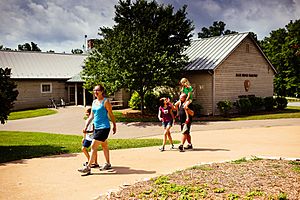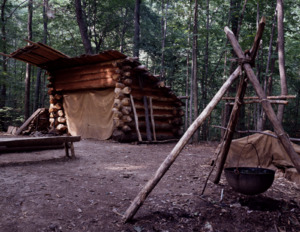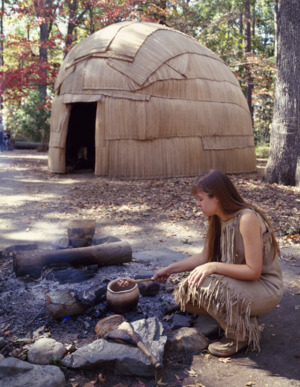Explore Park facts for kids
Quick facts for kids Explore Park |
|
|---|---|

Blue Ridge Parkway Visitor Center at Explore Park
|
|
| Lua error in Module:Location_map at line 420: attempt to index field 'wikibase' (a nil value). | |
| Nearest city | Roanoke, Virginia |
| Area | 1,100 acres (450 ha) |
| Created | 1985 |
| Operated by | Roanoke County, Department of Parks, Recreation and Tourism |
| Visitors | 18,000 (2014) |
| Open | July 2, 1994 |
Explore Park is a huge park, about 1100 acres big, in Roanoke County, Virginia. It's managed by Roanoke County's Parks and Recreation department. You can find it right on the Blue Ridge Parkway, a famous scenic road. Most of the park is in Roanoke County, but some of it stretches into Bedford County too.
The park has old buildings that have been carefully restored. It also offers lots of trails for hiking and biking. You can even get to the Roanoke River from the park for fun activities. Explore Park is located near a gorge where the Roanoke River flows out of the Roanoke Valley.
Contents
The Story of Explore Park
Explore Park was created to be a fun place for visitors in western Virginia. In the 1980s, local leaders formed a group called the River Foundation. They wanted to build a cool attraction. The state government then created the Virginia Recreational Facilities Authority (VRFA) in 1986. This group worked with the River Foundation. Their main goal was to get people driving on the Blue Ridge Parkway to visit the Roanoke area.
The VRFA bought the land for the park in 1988. It cost about $6 million. This money came from the state government. Explore Park then became a Virginia state park. Over the years, a lot of money was invested in the park. By 2008, about $52 million had been spent to make it what it is today.
Early Ideas and Opening
At first, people had big ideas for Explore Park. Some thought about making the Mill Mountain Zoo bigger. Others imagined a history theme park. This park would teach visitors about the famous Lewis and Clark journey. Bern Ewart, who was the city manager of Roanoke at the time, even left his job to help build the park.
However, there wasn't enough money for these huge plans. So, the park became a smaller "living history museum." It focused on the early history of Southwest Virginia. Work on today's Explore Park began on September 10, 1991. They started by rebuilding the Hofauger House, which was built in 1837.
The River Foundation gave control of the park to the VRFA on July 1, 1994. The very next day, July 2, 1994, Explore Park opened to the public! Between 1991 and 2002, more historical buildings were added. These included a working tavern and a grist mill.
Changes and Re-Opening
In 2001, the state stopped giving money to the park. So, Roanoke County promised to help pay for it for five years. A few years later, in 2005, a company called Virginia Living Histories (VLH) had a plan. They wanted to turn Explore Park into a huge tourist spot. VLH wanted to invest a lot of money, possibly up to $200 million!
However, things didn't go as planned. In 2007, it was announced that the park would close for the 2008 season. The VRFA didn't have enough money to keep it running. So, the park's historical buildings were closed. Only the Blue Ridge Parkway Visitor's Center stayed open. People were sad about the closure. One 9-year-old boy, William Cathey, hoped something new would be built, but he thought it might not be as good.
Because of a worldwide economic problem, VLH couldn't get the money they needed. Their plans for a big resort with zip lines and golf courses didn't happen. So, their agreement ended in 2010.
In October 2013, Explore Park reopened! Roanoke County bought the park and now runs it. Since the county took over, more people have visited. In 2014, over 18,000 people came to the park. The county wants to make Explore Park an "outdoor adventure park." They plan to add cabins, RV parks, and even more zip lines. They are working on a big plan for the park's future.
Explore Park's Historical Area
The historical area at Explore Park has many old buildings. These buildings are from the 18th and 19th centuries. They were moved from their original spots and rebuilt here. After the park closed in 2007, these buildings are not usually open to the public. But you can rent the Mountain Union Church for special events, like weddings.
Here are some of the interesting buildings you can find:
- Mountain Union Church — This church opened in 1998. It was originally built in the early 1800s in Botetourt County.
- Brugh Tavern — This tavern opened in 1998 as a restaurant. It was originally located near the Great Wagon Road in Botetourt County.
- Roanoke Explorer Batteau — This boat opened in 1999. It shows how goods were moved on rivers before railroads. It also highlights how freed slaves often started businesses with these boats.
- Totero Village — This village opened in 2002. It has houses, work shelters, and a garden. It looks like a Native American village from the late 1600s.
- Slone's Grist Mill — This mill opened in 2002. It was built between 1880 and 1890 in Franklin County.
- Frontier Fort — This fort opened in 2004. It was built using logs from the park. It looks like a fort built by Ephraim Vause in the 1700s.
- Blacksmith Shop — This shop is like the old blacksmith shops on the Great Wagon Road.
- Hofauger House — This house was originally built in 1837 in Roanoke County.
- Houtz Barn — This is a German-style barn. It was originally on a farm near Salem.
- Kemp's Ford School House — This is a single-room schoolhouse. It was originally near the Blackwater River in Franklin County.
- Leninger Cabin — This cabin was built in 2010 for a movie called Alone yet Not Alone. It looks like a log cabin from the 1750s.
Other Park Features
Besides the historical buildings, Explore Park also has other features for visitors:
- Arthur Taubman Welcome Center — This building opened in 1998. It serves as the main entrance to the park.
- Blue Ridge Parkway Visitor Center — This center opened in 2001. It teaches visitors about the Blue Ridge Parkway. It was the only building that stayed open after 2007.
- Salem Turnpike — This road opened in 2002. It is a 1.8-mile road that goes around the Historical Area.



